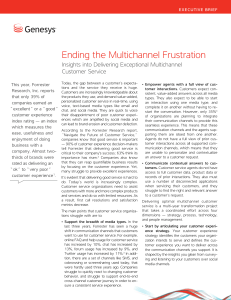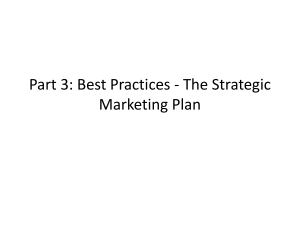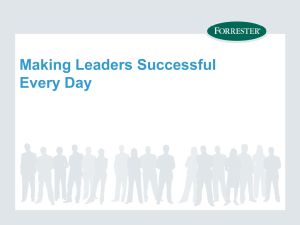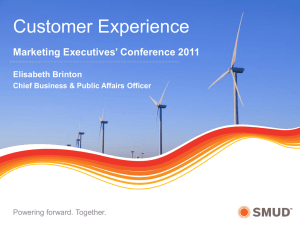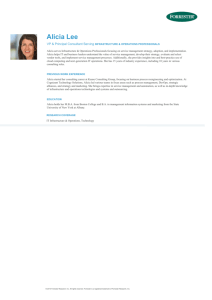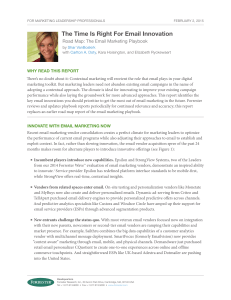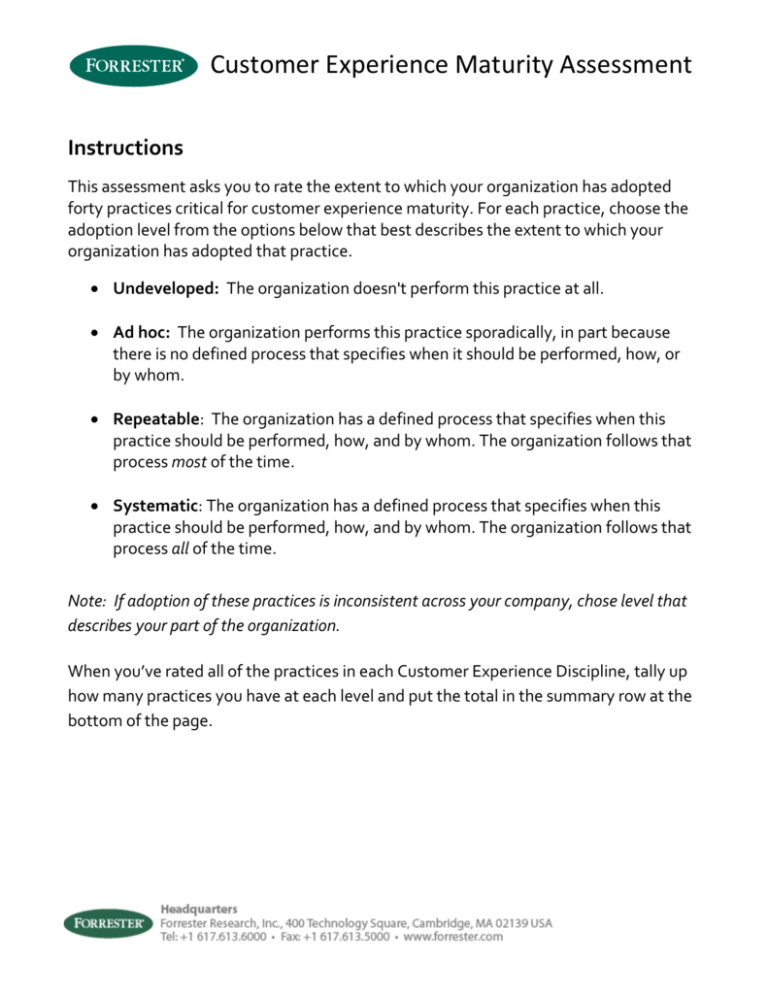
Customer Experience Maturity Assessment
Instructions
This assessment asks you to rate the extent to which your organization has adopted
forty practices critical for customer experience maturity. For each practice, choose the
adoption level from the options below that best describes the extent to which your
organization has adopted that practice.
Undeveloped: The organization doesn't perform this practice at all.
Ad hoc: The organization performs this practice sporadically, in part because
there is no defined process that specifies when it should be performed, how, or
by whom.
Repeatable: The organization has a defined process that specifies when this
practice should be performed, how, and by whom. The organization follows that
process most of the time.
Systematic: The organization has a defined process that specifies when this
practice should be performed, how, and by whom. The organization follows that
process all of the time.
Note: If adoption of these practices is inconsistent across your company, chose level that
describes your part of the organization.
When you’ve rated all of the practices in each Customer Experience Discipline, tally up
how many practices you have at each level and put the total in the summary row at the
bottom of the page.
Discipline 1: Strategy
The following practices enable the organization to define a clear vision of the type of experience the
company seeks to deliver, link that vision to the company’s brand, and apply it to guide the activities
and resources of the organization.
Practice
Adoption
1. Define a customer experience strategy that
describes the intended customer experience, flows
from overall company strategy, and aligns with
the organization's brand attributes.
U A
R S
2. Share the customer experience strategy with all
employees (e.g., distribute documentation,
conduct training sessions).
U A
R S
3. Include alignment with the customer experience
strategy as a criterion for evaluating project
funding and prioritization decisions.
U A
R S
Notes
Total
© 2011, Forrester Research, Inc. All rights reserved. Unauthorized reproduction is strictly prohibited. Information is based on best available resources.
Opinions reflect judgment at the time and are subject to change. Forrester®, Technographics®, Forrester Wave, RoleView, TechRadar, and Total Economic
Impact are trademarks of Forrester Research, Inc. All other trademarks are the property of their respective companies. For additional information, go to
www.forrester.com.
Discipline 2: Customer Understanding
The following practices enable the organization to create and maintain a clear, consistent, and
accurate picture of target customers and the experiences they want, even in the face of changing
customer expectations.
Practice
Adoption
4. Solicit feedback from customers about their
experiences with the organization (e.g., through
surveys, interviews, or usability studies).
U A
R S
5. Collect unsolicited feedback from customers about
their experiences with the organization (e.g., by mining
calls, emails, or postings on social media networks).
U A
R S
6. Gather input from employees about their experiences
with customers and their role in the customer
experience ecosystem.
U A
R S
7. Conduct observational research studies in customers'
natural environment (e.g., observing customer’s real
life activities, shadowing).
U A
R S
8. Map customers' interactions with the organization
across multiple channels and touchpoints.
U A
R S
9. Analyze customer insight drawn from across research
techniques and organizational boundaries to identify
key customer pain points and opportunities.
U A
R S
10. Document customer understanding in a way that is
easy for employees to understand and use (e.g.
personas, customer journey maps, and role-based
Voice of the Customer reports).
U A
R S
11. Share customer understanding with all employees
(e.g., distribute documentation, conduct training
sessions).
U A
R S
Notes
Total
© 2011, Forrester Research, Inc. All rights reserved. Unauthorized reproduction is strictly prohibited. Information is based on best available resources.
Opinions reflect judgment at the time and are subject to change. Forrester®, Technographics®, Forrester Wave, RoleView, TechRadar, and Total Economic
Impact are trademarks of Forrester Research, Inc. All other trademarks are the property of their respective companies. For additional information, go to
www.forrester.com.
Discipline 3: Design
The following practices enable the organization to determine the exact characteristics of interactions
that meet or exceed customer expectations of the brand.
Practice
Adoption
12. Follow a defined customer experience design
process any time a new experience is introduced
or an existing experience is changed in a
significant way.
U A
R S
13. Use customer understanding deliverables and
insights to focus and define requirements for
projects, products, and services that affect
customer experiences.
U A
R S
14. Identify the set of complex interdependencies
among people, processes, and technologies that
shape interactions with customers.
U A
R S
15. Engage customers, partners, and employees as
part of the experience design process (i.e., cocreation).
U A
R S
16. Use multiple iterations of ideation, prototyping,
and customer evaluation as part of the experience
design (and re-design) process.
U A
R S
17. Whenever a change is approved to a policy,
business process, product, technology, or other
system that affects the customer experience,
proactively adjust the design of that experience to
reflect the change.
U A
R S
Notes
Total
© 2011, Forrester Research, Inc. All rights reserved. Unauthorized reproduction is strictly prohibited. Information is based on best available resources.
Opinions reflect judgment at the time and are subject to change. Forrester®, Technographics®, Forrester Wave, RoleView, TechRadar, and Total Economic
Impact are trademarks of Forrester Research, Inc. All other trademarks are the property of their respective companies. For additional information, go to
www.forrester.com.
Discipline 4: Governance
The following practices enable the organization monitor and manage customer experience quality in a
proactive way as part of the overall corporate governance system.
Practice
Adoption
18. Define a consistent set of customer experience
standards across the organization.
U A
R S
19. Assign customer experience management tasks to
specific roles as a requirement of those positions.
U A
R S
20. Maintain a dedicated queue of customer experience
improvement projects.
U A
R S
21. Review customer experience program status and
metrics regularly to monitor progress toward
business goals, adjusting tactics or resource
allocations if needed.
U A
R S
22. Respond to individual customers based on their
feedback about an experience.
U A
R S
23. Include 'impact to customer experience' as a criterion
for business decisions about policies, processes,
technology, and communications.
U A
R S
24. Include performance on role-specific customer
experience metrics in the systems for evaluating
employee performance.
U A
R S
25. Facilitate the necessary coordination across groups
that share responsibility for a given experience.
U A
R S
Notes
Total
© 2011, Forrester Research, Inc. All rights reserved. Unauthorized reproduction is strictly prohibited. Information is based on best available resources.
Opinions reflect judgment at the time and are subject to change. Forrester®, Technographics®, Forrester Wave, RoleView, TechRadar, and Total Economic
Impact are trademarks of Forrester Research, Inc. All other trademarks are the property of their respective companies. For additional information, go to
www.forrester.com.
Discipline 5: Culture
The following practices enable the organization to create and maintain a culture in which delivering a
great customer experience is embedded in the organization’s DNA.
Practice
Adoption
26. Communicate the importance of customer
experience to employees, customers, and other
stakeholders (e.g. shareholders, partners).
U A
R S
27. Collect and share stories of customer experience
best practices across the employee base.
U A
R S
28. Screen candidates for customer-centric values as
part of the hiring and selection process.
U A
R S
29. Screen candidates for the specific skills needed to
deliver on the organization's customer experience
strategy as part of the hiring and selection
process.
U A
R S
30. Provide training to help new and existing
employees build and maintain the skills they need
to deliver on their part of the organization’s
customer experience strategy.
U A
R S
31. Perform rituals and routines that reinforce the
importance of customer experience and what it
takes to deliver it.
U A
R S
32. Use informal rewards and celebrations to highlight
exemplary customer-centric behavior.
U A
R S
33. Connect formal reward structures to performance
on customer experience metrics (e.g., bonuses,
promotions).
U A
R S
Notes
Total
© 2011, Forrester Research, Inc. All rights reserved. Unauthorized reproduction is strictly prohibited. Information is based on best available resources.
Opinions reflect judgment at the time and are subject to change. Forrester®, Technographics®, Forrester Wave, RoleView, TechRadar, and Total Economic
Impact are trademarks of Forrester Research, Inc. All other trademarks are the property of their respective companies. For additional information, go to
www.forrester.com.
Discipline 6: Measurement
The following practices enable the organization to measure customer experience quality on an
ongoing basis across the entire enterprise, and use that data to drive continuous improvement.
Practice
Adoption
34. Define a customer experience quality framework that
aligns with how customers judge an experience, and
is consistent across the organization (i.e. channels,
lines of business).
U A
R S
35. Measure how customers perceive their experiences
with the organization based on the criteria in the
customer experience quality framework.
U A
R S
36. Collect operational metrics about each experience
(e.g. length of interactions, errors encountered) that
provide context for customer perceptions.
U A
R S
37. Define the subsets of customer experience metrics
that show how each group, role, and individual in the
organization contributes to customer experinece
quality.
U A
R S
38. Analyze customer experience metrics to determine
differences in experience quality among key
customer segments, tasks (e.g., buying a product,
getting service), or aspects of the experience (e.g.,
friendliness of staff).
U A
R S
39. Model the relationship between drivers of customer
experience quality (e.g. speed, accuracy), customer
perceptions of their experiences (e.g., easy, reliable),
and business outcomes (e.g., increased sales, calls to
care averted).
U A
R S
40. Share customer experiences metrics and models with
all employees (e.g., distribute reports and
dashboards, conduct training sessions).
U A
R S
Notes
Total
© 2011, Forrester Research, Inc. All rights reserved. Unauthorized reproduction is strictly prohibited. Information is based on best available resources.
Opinions reflect judgment at the time and are subject to change. Forrester®, Technographics®, Forrester Wave, RoleView, TechRadar, and Total Economic
Impact are trademarks of Forrester Research, Inc. All other trademarks are the property of their respective companies. For additional information, go to
www.forrester.com.
Summary
Undeveloped
Ad Hoc
Repeatable
Systematic
Don’t Know
Enter the totals from each discipline into the following chart to get a big-picture view of your current
maturity landscape.
Strategy
0
0
0
0
0
Customer Understanding
0
0
0
0
0
Design
0
0
0
0
0
Governance
0
0
0
0
0
Culture
0
0
0
0
0
Measurement
0
0
0
0
0
Total
0
0
0
0
0
Discipline
© 2011, Forrester Research, Inc. All rights reserved. Unauthorized reproduction is strictly prohibited. Information is based on best available resources.
Opinions reflect judgment at the time and are subject to change. Forrester®, Technographics®, Forrester Wave, RoleView, TechRadar, and Total Economic
Impact are trademarks of Forrester Research, Inc. All other trademarks are the property of their respective companies. For additional information, go to
www.forrester.com.

